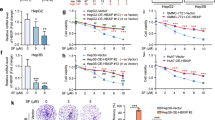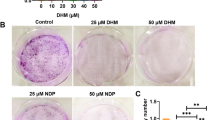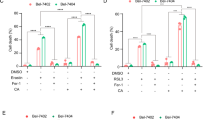Abstract
Hepatocellular carcinoma (HCC) has high morbidity and mortality, and effective therapies are lacking. Gallic acid (GA), a natural phenolic compound derived from plants, has been reported to prevent the onset and progression of various cancers. However, there is limited elaboration on the potential mechanisms and anticancer effects of GA on hepatocellular carcinoma. Inducing ferroptosis of tumor cells has become one of the most promising ways to eradicate tumor cells. However, the effect of GA on HCC ferroptosis remains unknown. We evaluated the impact of GA on cell viability, migration, and mitochondrial morphology in HepG2 cells. Our study identified a critical role of GA in inducing ferroptosis in HepG2 cells. Mechanistically, we found that GA could inhibit the expression of a ferroptosis-related protein SLC7A11 and GPX4 in HepG2, by blocking β‐catenin transport from nuclear to the cytoplasm, thus inducing the inactivation of the Wnt/β‐catenin pathway. Our study has confirmed that GA is a novel ferroptosis inducer of HC, suggesting GA could be a promising candidate for the clinical treatment of HCC.





Similar content being viewed by others
Data availability
The datasets used and/or analyzed during the current study are available from the corresponding author on reasonable request.
References
Aglan HA, Ahmed HH, El-Toumy SA, Mahmoud NS (2017) Gallic acid against hepatocellular. carcinoma: an integrated scheme of the potential mechanisms of action from in vivo study. Tumour Biol. 39(6). https://doi.org/10.1177/1010428317699127
Alfei S, Marengo B, Zuccari G, Turrini F, Domenicotti C (2020) Dendrimer nanodevices and gallic acid as novel strategies to fight chemoresistance in neuroblastoma cells. Nanomaterials (Basel). 10(6). https://doi.org/10.3390/nano10061243
Bray F, Ferlay J, Soerjomataram I, Siegel RL, Torre LA, Jemal A (2018) Global cancer statistics 2018: GLOBOCAN estimates of incidence and mortality worldwide for 36 cancers in 185 countries. CA Cancer J Clin 68(6):394–424. https://doi.org/10.3322/caac.21492
Fan Z, Duan J, Wang L, Xiao S, Li L, Yan X, Yao W, Wu L, Zhang S, Zhang Y, Li Y, Zhu X, Hu Y, Zhang D, Jiao S, Xu X (2019) PTK2 promotes cancer stem cell traits in hepatocellular carcinoma by activating wnt/β-catenin signaling. Cancer Lett 450:132–143. https://doi.org/10.1016/j.canlet.2019.02.040
Fu Y, Chung FL (2018) Oxidative stress and hepatocarcinogenesis. Hepatoma Res. 4:39. https://doi.org/10.20517/2394-5079.2018.29
Hong Z, Tang P, Liu B, Ran C, Yuan C, Zhang Y, Lu Y, Duan X, Yang Y, Wu H (2021) Ferroptosis-related genes for overall survival prediction in patients with colorectal cancer can be inhibited by gallic acid. Int J Biol Sci 17(4):942–956. https://doi.org/10.7150/ijbs.57164
Hsu JD, Kao SH, Ou TT, Chen YJ, Li YJ, Wang CJ (2011) Gallic acid induces G2/M phase arrest of breast cancer cell MCF-7 through stabilization of p27(Kip1) attributed to disruption of p27(Kip1)/Skp2 complex. J Agric Food Chem 59(5):1996–2003. https://doi.org/10.1021/jf103656v
Ihara A, Koizumi H, Hashizume R, Uchikoshi T (1996) Expression of epithelial cadherin and alpha- and beta-catenins in nontumoral livers and hepatocellular carcinomas. Hepatology 23(6):1441–1447. https://doi.org/10.1053/jhep.1996.v23.pm0008675162
Ji X, Qian J, Rahman SMJ, Siska PJ, Zou Y, Harris BK, Hoeksema MD, Trenary IA, Heidi C, Eisenberg R, Rathmell JC, Young JD, Massion PP (2018) xCT (SLC7A11)-mediated metabolic reprogramming promotes non-small cell lung cancer progression. Oncogene. 37(36):5007–5019. https://doi.org/10.1038/s41388-018-0307-z
Karabicici M, Azbazdar Y, Ozhan G, Senturk S, FirtinaKaragonlar Z, Erdal E (2021) Changes in wnt and TGF-β signaling mediate the development of regorafenib resistance in hepatocellular carcinoma cell line HuH7. Front Cell Dev Biol 9:639779. https://doi.org/10.3389/fcell.2021.639779
Kim DH, Kim WD, Kim SK, Moon DH, Lee SJ (2020) TGF-β1-mediated repression of SLC7A11 drives vulnerability to GPX4 inhibition in hepatocellular carcinoma cells. Cell Death Dis 11(5):406. https://doi.org/10.1038/s41419-020-2618-6
Konieczkowski DJ, Johannessen CM, Garraway LA (2018) A convergence-based framework for cancer drug resistance. Cancer Cell 33(5):801–815. https://doi.org/10.1016/j.ccell.2018.03.025
Koppula P, Zhang Y, Zhuang L, Gan B (2018) Amino acid transporter SLC7A11/xCT at the crossroads of regulating redox homeostasis and nutrient dependency of cancer. Cancer Commun (lond) 38(1):12. https://doi.org/10.1186/s40880-018-0288-x
Koppula P, Zhuang L, Gan B (2021) Cystine transporter SLC7A11/xCT in cancer: ferroptosis, nutrient dependency, and cancer therapy. Protein Cell 12(8):599–620. https://doi.org/10.1007/s13238-020-00789-5
Ladd AD, Duarte S, Sahin I, Zarrinpar A (2023) Mechanisms of drug resistance in HCC. Hepatology. https://doi.org/10.1097/HEP.0000000000000237
Lang X, Green MD, Wang W et al (2019) Radiotherapy and immunotherapy promote tumoral lipid oxidation and ferroptosis via synergistic repression of SLC7A11. Cancer Discov 9(12):1673–1685. https://doi.org/10.1158/2159-8290.CD-19-0338
Lee SH, Koo BS, Kim JM, Huang S, Rho YS, Bae WJ, Kang HJ, Kim YS, Moon JH, Lim YC (2014) Wnt/β-catenin signalling maintains self-renewal and tumourigenicity of head and neck squamous cell carcinoma stem-like cells by activating Oct4. J Pathol 234(1):99–107. https://doi.org/10.1002/path.4383
Lee H, Zandkarimi F, Zhang Y, Meena JK, Kim J, Zhuang L, Tyagi S, Ma L, Westbrook TF, Steinberg GR, Nakada D, Stockwell BR, Gan B (2020) Energy-stress-mediated AMPK activation inhibits ferroptosis. Nat Cell Biol 22(2):225–234. https://doi.org/10.1038/s41556-020-0461-8
Lei G, Zhang Y, Koppula P, Liu X, Zhang J, Lin SH, Ajani JA, Xiao Q, Liao Z, Wang H, Gan B (2020) The role of ferroptosis in ionizing radiation-induced cell death and tumor suppression. Cell Res 30(2):146–162. https://doi.org/10.1038/s41422-019-0263-3
Leung HW, Leung CON, Lau EY, Chung KPS, Mok EH, Lei MML, Leung RWH, Tong M, Keng VW, Ma C, Zhao Q, Ng IOL, Ma S, Lee TK (2021) EPHB2 activates β-catenin to enhance cancer stem cell properties and drive sorafenib resistance in hepatocellular carcinoma. Cancer Res 81(12):3229–3240. https://doi.org/10.1158/0008-5472.CAN-21-0184
Liang C, Zhang X, Yang M, Dong X (2019) Recent progress in ferroptosis inducers for cancer therapy. Adv Mater 31(51):e1904197. https://doi.org/10.1002/adma.201904197
Lv MY, Shi CJ, Pan FF, Shao J, Feng L, Chen G, Ou C, Zhang JF, Fu WM (2019) Urolithin B suppresses tumor growth in hepatocellular carcinoma through inducing the inactivation of wnt/β-catenin signaling. J Cell Biochem 120(10):17273–17282. https://doi.org/10.1002/jcb.28989
Mori T, Koyama N, Yokoo T, Segawa T, Maeda M, Sawmiller D, Tan J, Town T (2020) Gallic acid is a dual α/β-secretase modulator that reverses cognitive impairment and remediates pathology in alzheimer mice. J Biol Chem 295(48):16251–16266. https://doi.org/10.1074/jbc.RA119.012330
Pang F, Ding S, Li N, Li Z, Tian N, Shi C, Zhang F, Mai Y, Zhang J, Wang J (2023) Gallic acid mediates tumor-suppressive effects on osteosarcoma through the H19-wnt/β-catenin regulatory axis. J Orthop Translat 39:34–42. https://doi.org/10.1016/j.jot.2022.12.003
Parsons MJ, Tammela T, Dow LE (2021) WNT as a driver and dependency in cancer. Cancer Discov 11(10):2413–2429. https://doi.org/10.1158/2159-8290.CD-21-0190
Perez MA, Magtanong L, Dixon SJ, Watts JL (2020) Dietary lipids induce ferroptosis in caenorhabditiselegans and human cancer cells. Dev Cell 54(4):447-454.e4. https://doi.org/10.1016/j.devcel.2020.06.019
Perugorria MJ, Olaizola P, Labiano I, Esparza-Baquer A, Marzioni M, Marin JJG, Bujanda L, Banales JM (2019) Wnt-β-catenin signalling in liver development, health and disease. Nat Rev Gastroenterol Hepatol 16(2):121–136. https://doi.org/10.1038/s41575-018-0075-9
Shi CJ, Zheng YB, Pan FF, Zhang FW, Zhuang P, Fu WM (2021) Gallic acid suppressed. tumorigenesis by an LncRNA MALAT1-wnt/β-catenin Axis in hepatocellular carcinoma. Front Pharmacol. 2:708967. https://doi.org/10.3389/fphar.2021.708967
Stockwell BR, FriedmannAngeli JP, Bayir H, Bush AI, Conrad M, Dixon SJ, Fulda S, Gascón S, Hatzios SK, Kagan VE, Noel K, Jiang X, Linkermann A, Murphy ME, Overholtzer M, Oyagi A, Pagnussat GC, Park J, Ran Q, Rosenfeld CS, Salnikow K, Tang D, Torti FM, Torti SV, Toyokuni S, Woerpel KA, Zhang DD (2017) Ferroptosis: a regulated cell death nexus linking metabolism, redox biology, and disease. Cell 171(2):273–285. https://doi.org/10.1016/j.cell.2017.09.021
Sun G, Zhang S, Xie Y, Zhang Z, Zhao W (2016) Gallic acid as a selective anticancer agent that induces apoptosis in SMMC-7721 human hepatocellular carcinoma cells. Oncol Lett 11(1):150–158. https://doi.org/10.3892/ol.2015.3845
Tang HM, Cheung PCK (2019) Gallic acid triggers iron-dependent cell death with apoptotic, ferroptotic, and necroptotic features. Toxins (basel) 11(9):492. https://doi.org/10.3390/toxins11090492
Tor YS, Yazan LS, Foo JB, Wibowo A, Ismail N, Cheah YK, Abdullah R, Ismail M, Ismail IS, Yeap SK (2015) Induction of apoptosis in MCF-7 cells via oxidative stress generation, mitochondria-dependent and caspase-independent pathway by ethyl acetate extract of Dillenia suffruticosa and its chemical profile. PLoS ONE 10(6):e0127441. https://doi.org/10.1371/journal.pone.0127441
Vogel A, Meyer T, Sapisochin G, Salem R, Saborowski A (2022) Hepatocellular carcinoma. Lancet 400(10360):1345–1362. https://doi.org/10.1016/S0140-6736(22)01200-4
Wang K, Zhu X, Zhang K, Zhu L, Zhou F (2014) Investigation of gallic acid induced anticancer effect in human breast carcinoma MCF-7 cells. J Biochem Mol Toxicol 28(9):387–393. https://doi.org/10.1002/jbt.21575
Wang H, Zhang H, Chen Y, Wang H, Tian Y, Yi X, Shi Q, Zhao T, Zhang B, Gao T, Guo S, Li C, Guo W (2022a) Targeting wnt/β-catenin signaling exacerbates ferroptosis and increases the efficacy of melanoma immunotherapy via the regulation of MITF. Cells 11(22):3580. https://doi.org/10.3390/cells11223580
Wang Y, Zheng L, Shang W, Yang Z, Li T, Liu F, Shao W, Lv L, Chai L, Qu L, Xu Q, Du J, Liang X, Zeng J, Jia J (2022b) Wnt/beta-catenin signaling confers ferroptosis resistance by targeting GPX4 in gastric cancer. Cell Death Differ 29(11):2190–2202. https://doi.org/10.1038/s41418-022-01008-w
Xu J, Prosperi JR, Choudhury N, Olopade OI, Goss KH (2015) β-Catenin is required for the tumorigenic behavior of triple-negative breast cancer cells. PLoS ONE 10(2):e0117097. https://doi.org/10.1371/journal.pone.0117097
Yan X, Liu Y, Li C, Mao X, Xu T, Hu Z, Zhang C, Lin N, Lin Y, Zhang Y (2023) Pien-tze-huang prevents hepatocellular carcinoma by inducing ferroptosis via inhibiting SLC7A11-GSH-GPX4 axis. Cancer Cell Int 23(1):109. https://doi.org/10.1186/s12935-023-02946-2
Zhao B, Hu M (2013) Gallic acid reduces cell viability, proliferation, invasion and angiogenesis in human cervical cancer cells. Oncol Lett 6(6):1749–1755. https://doi.org/10.3892/ol.2013.1632
Zhao Y, Li Y, Zhang R, Wang F, Wang T, Jiao Y (2020) The role of erastin in ferroptosis and its prospects in cancer therapy. Onco Targets Ther 13:5429–5441. https://doi.org/10.2147/OTT.S254995
Zheng R, Qu C, Zhang S, Zeng H, Sun K, Gu X, Xia C, Yang Z, Li H, Wei W, Chen W, He J (2018) Liver cancer incidence and mortality in China: temporal trends and projections to 2030. Chin J Cancer Res. 30(6):571–579. https://doi.org/10.21147/j.issn.1000-9604.2018.06.01
Funding
This work was supported by grants from the Hunan University of Chinese Medicine graduate innovation project (2022CX67), the key project of first-class discipline of integrated Traditional Chinese and Western Medicine (2021ZXYJH02), and the Key Discipline of Basic Medicine, Hunan University of Chinese Medicine (202302).
Author information
Authors and Affiliations
Contributions
YC and YL conceived and designed the research. JX, HW, and WX performed experiments. JX analyzed and plotted data. JX and YL prepared Figs. 1–5. YC, YL, and JX wrote and revised the manuscript. All authors read and approved the manuscript. The authors declare that all data were generated in-house and that no paper mill was used.
Corresponding authors
Ethics declarations
Ethical approval
Not applicable.
Competing interests
The authors declare no competing interests.
Additional information
Publisher's Note
Springer Nature remains neutral with regard to jurisdictional claims in published maps and institutional affiliations.
Rights and permissions
Springer Nature or its licensor (e.g. a society or other partner) holds exclusive rights to this article under a publishing agreement with the author(s) or other rightsholder(s); author self-archiving of the accepted manuscript version of this article is solely governed by the terms of such publishing agreement and applicable law.
About this article
Cite this article
Xie, J., Wang, H., Xie, W. et al. Gallic acid promotes ferroptosis in hepatocellular carcinoma via inactivating Wnt/β-catenin signaling pathway. Naunyn-Schmiedeberg's Arch Pharmacol 397, 2437–2445 (2024). https://doi.org/10.1007/s00210-023-02770-5
Received:
Accepted:
Published:
Issue Date:
DOI: https://doi.org/10.1007/s00210-023-02770-5




